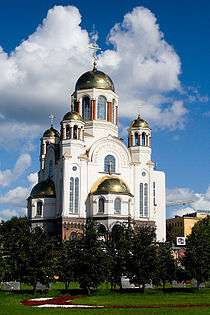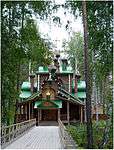Canonization of the Romanovs
| Tsar Nicholas II of Russia and Family | |
|---|---|
 | |
| Royal Martyrs, Tsar Nicholas II of Russia and Family (ROCOR) Royal Passion-Bearers, Tsar Nicholas II of Russia and Family (Moscow Patriarchate) | |
| Born |
18 May [O.S. 6 May] 1868 (Nicholas II) 6 June [O.S. 25 May] 1872 (Tsarina Alexandra) 15 November [O.S. 3 November] 1895 (Olga) 10 June [O.S. 29 May] 1897 (Tatiana) 26 June [O.S. 14 June] 1899 (Maria) 18 June [O.S. 5 June] 1901 (Anastasia) 12 August [O.S. 30 July] 1904 (Alexei) Peterhof, Russia; New Palace, Darmstadt, Hesse, German Empire (Tsarina Alexandra) |
| Died |
17 July 1918 Yekaterinburg, Russia |
| Venerated in |
MOSPAT ROCOR |
| Canonized | 1981 and 2000, United States and Russia by Russian Orthodox Church Abroad and the Moscow Patriarchate |
| Major shrine | Church on Blood, Yekaterinburg, Russia |
| Feast | 17 July [O.S. 4 July] |
| Wikimedia Commons has media related to Tsar family icons. |
The canonization of the Romanovs was the elevation to sainthood of the last Imperial Family of Russia – Tsar Nicholas II, his wife Tsarina Alexandra, and their five children Olga, Tatiana, Maria, Anastasia, and Alexei – by the Russian Orthodox Church. The family was killed by the Bolsheviks on 17 July 1918 at the Ipatiev House in Yekaterinburg; the site of their execution is now beneath the altar of the Church on Blood. They are variously designated as new martyrs by the Russian Orthodox Church Abroad and as passion bearers by the church inside Russia.
The family was canonized on 1 November 1981 as new martyrs by the Russian Orthodox Church Abroad. They were canonized along with their servants, who had been killed along with them. The canonized servants were their court physician, Yevgeny Botkin; their footman Alexei Trupp; their cook, Ivan Kharitonov; and Alexandra's maid, Anna Demidova. Also canonized were two servants killed in September 1918, lady in waiting Anastasia Hendrikova and tutor Catherine Adolphovna Schneider. All were canonized as victims of oppression by the Bolsheviks. The Russian Orthodox Church did not canonize the servants, two of whom were not Russian Orthodox: Trupp was Roman Catholic, and Schneider was Lutheran.
Alexandra's sister, Grand Duchess Elizabeth Fyodorovna, who was murdered by the Bolsheviks on 18 July 1918, was canonized on 1 November 1981 as New-Martyr Elizabeth by the Russian Orthodox Church Abroad, along with Prince Ioann Konstantinovich of Russia, Prince Igor Konstantinovich of Russia, Prince Konstantine Konstantinovich of Russia, Grand Duke Sergey Mikhaylovich of Russia, and Prince Vladimir Pavlovich Paley, and Elizabeth's faithful companion, Sister Varvara Yakovleva, who were all killed with her. Fyodor Remez, Grand Duke Sergei's personal secretary, who was killed as well, was not canonized. They are known as the Martyrs of Alapaevsk.
In 1992, Grand Duchess Elizabeth Fyodorovna and Varvara Yakovleva were canonized as New-Martyr Elizabeth and New-Martyr Barbara by the Moscow Patriarchate. The grand dukes and others killed with them were not canonized.
On 20 August 2000, after much debate, the Romanov family was canonized as passion bearers by the Moscow Patriarchate.
Controversy
The canonizations were controversial for both branches of the Russian Orthodox Church. In 1981, opponents noted Nicholas II's perceived weaknesses as a ruler and felt his actions led to the resulting Bolshevik Revolution. One priest of the Russian Orthodox Church Abroad noted that martyrdom in the Russian Orthodox Church has nothing to do with the martyr's personal actions but is instead related to why he or she was killed.[1] Other critics noted that the Russian Orthodox Church Abroad appeared to be blaming Jewish revolutionaries for the deaths and equating the political assassination with a ritual murder.[2]
There were those who rejected the family's classification as martyrs because they were not killed because of their religious faith. There was no proof that the execution was a ritual murder. Religious leaders in both churches also had objections to canonizing the Tsar's family because they perceived him as a weak emperor whose incompetence led to the revolution, the suffering of his people and made him at least partially responsible for his own murder and the murders of his wife and children. For these opponents, the fact that the Tsar was, in private life, a kind man and a good husband and father did not override his poor governance of Russia.[1]
The Moscow Patriarchate ultimately canonized the family as passion bearers: people who face death with resignation, in a Christ-like manner, as distinguished from martyrs, the latter killed explicitly for their faith. Proponents cited previous Tsars and Tsareviches who had been canonized as passion bearers, such as Tsarevich Dimitri, murdered at the end of the sixteenth century, as setting a precedent for the canonization of the Romanov family. They noted the piety of the family and reports that the Tsarina and her eldest daughter Olga prayed and attempted to make the sign of the cross immediately before they died.
Despite their official designation as "passion-bearers" by the August 2000 Council, they are nevertheless spoken of as "martyrs" in Church publications, icons, and in popular veneration by the people.[3][4]
The bodies of Tsar Nicholas II, Tsarina Alexandra, and three of their daughters were finally interred at St. Peter and Paul Cathedral in St. Petersburg on 17 July 1998, eighty years after they were murdered. The bodies of Alexei and one of his sisters were at the time missing.[5] On 23 August 2007, a Russian archaeologist announced the discovery of two burned, partial skeletons at a bonfire site at Ganina Yama near Yekaterinburg that appeared to match the site described in assassin Yakov Yurovsky's memoirs. The archaeologists said the bones are from a boy who was roughly between the ages of ten and thirteen years at the time of his death and of a young woman who was roughly between the ages of eighteen and twenty-three years old. Anastasia was seventeen years, one month old at the time of the assassination, while her sister Maria was nineteen years, one month old and her brother Alexei was two weeks shy of his fourteenth birthday. Anastasia's elder sisters Olga and Tatiana were twenty-two and twenty-one years old at the time of the assassination. Along with the remains of the two bodies, archaeologists found "shards of a container of sulfuric acid, nails, metal strips from a wooden box, and bullets of various caliber.".[6]
Preliminary testing indicated a "high degree of probability" that the remains belong to the Tsarevich Alexei and to one of his sisters, Russian forensic scientists announced on 22 January 2008.[7] The Yekaterinburg region's chief forensic expert Nikolai Nevolin indicated the results would be compared against those obtained by foreign experts.[8] On April 30, 2008, Russian forensic scientists announced that DNA testing proves that the remains belong to the Tsarevich Alexei and to one of his sisters.[9] With this result, all of the Tsar's family are accounted for.
Since the late 20th century, believers have attributed healing from illnesses or conversion to the Orthodox Church to their prayers to Maria and Alexei, as well as to the rest of the family.[10][11]
Gallery
 Yekaterinburg's "Church on the Blood," built on the spot where Nicholas II and his family were murdered in 1918
Yekaterinburg's "Church on the Blood," built on the spot where Nicholas II and his family were murdered in 1918 Church of St. Nicholas at the Romanov Monastery near the site where the Romanovs' remains were found at Ganina Yama
Church of St. Nicholas at the Romanov Monastery near the site where the Romanovs' remains were found at Ganina Yama An official portrait of the Romanov family in 1913
An official portrait of the Romanov family in 1913
Notes
- 1 2 Massie, Robert K., The Romanovs: The Final Chapter, Random House, ISBN 0-394-58048-6, 1995, pp. 134-135
- ↑ King, Greg, and Wilson, Penny, The Fate of the Romanovs, John Wiley and Sons, Inc., p. 495
- ↑ Patriarch Aleksy Visited the Place Where the Remains of the Royal Martyrs had been Burned, Yekaterinburg, September 23, 2000, Pravoslavie.ru
- ↑ GROUNDS FOR CANONIZATION OF THE TSAR FAMILY EXCERPTS FROM THE REPORT OF METROPOLITAN OF KRUTITSA AND KOLOMNA JUVENALY (Posted originally on the official web site of the Moscow Patriarchate)
- ↑ Shevchenko, Maxim (2000). "The Glorification of the Royal Family". Nezavisemaya Gazeta. Archived from the original on August 24, 2005. Retrieved December 10, 2006.
- ↑ Hammer, Joshua. "Resurrecting the Czar", Smithsonian Magazine, November 2010
- ↑ Interfax (2008). "Suspected remains of tsar's children still being studied". "Interfax". Retrieved January 23, 2008.
- ↑ RIA Novosti (2008). "Remains found in Urals likely belong to Tsar's children". "RIA Novosti". Retrieved January 23, 2008.
- ↑ Eckel, Mike (2008). "DNA confirms IDs of czar's children". yahoo.com. Archived from the original on May 1, 2008. Retrieved April 30, 2008.
- ↑ Serfes, Demetrios (2000). "Miracle of the Child Martyr Grand Duchess Maria". The Royal Martyrs of Russia. Retrieved February 25, 2007.
- ↑ Serfes, Demetrios (2000). "A Miracle Through the Prayers of Tsar Nicholas II and Tsarevich Alexis". The Royal Martyrs of Russia. Retrieved February 25, 2007.
External links
- In Memory of the Royal Martyrs, by St. John of Shanghai
- The Royal Martyrs of Russia (Fr. Netarios Serfes)
- New Martyrs, Confessors, and Passion-Bearers of Russia
- Video of the canonization of 1 November 1981 by the Russian Church Abroad
- Video of the canonization of 20 August 2000 by the Moscow Patriarchate